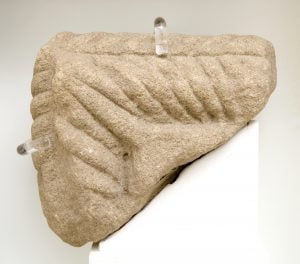
Home » Archaeology
Jarrow Hall houses archaeological finds from excavations on the monastic site of St Paul’s, Jarrow, as well as Jarrow Slake. The archaeological collection includes a wide range of artefacts, principally comprising Anglo-Saxon and Medieval material, with some Post-Medieval finds. This material includes (but is not limited to): coloured window glass, stone sculpture, ceramics, tiles, coins, copper alloy material, lead and iron objects, worked bone, animal bone and shellfish, clay pipes, painted wall plaster, bricks, and food preparation vessels.
The Jarrow Monastery was one of the most influential centres of learning in the 7th century, and the home of Venerable Bede. There was a magnificent guest-house on the river, named by excavators as ‘Building D’ where many beautiful artefacts and building material were excavated, including painted plaster, opus signinum, coloured window glass and other crafted objects. ‘Building D’ was later used as workshops.
Today you can visit St Paul’s Church, stand in the Saxon Chancel and see the 7th Century dedication stone, before visiting the neighbouring ruins of the excavated medieval monastery, which are managed by English Heritage.
Jarrow Hall has a permanent exhibition, dedicated to the finds from the excavated Jarrow monastery, in the wider context of Anglo-Saxon and Medieval Northumbria, where some of the excavated material can be seen on display. We also store and care for additional archaeological material, not currently on display.
The facsimile Codex Amiatinus and Coloured Saxon Window Glass are acknowledged as significant collections and featured as part of the Great Exhibition of the North’s A History of the North in 100 Objects.
Browse our online collections catalogue to see some of our items on display a little closer, as well as items kept in our stores. A lot of the material we hold are part of bulk finds, however, there are some real gems, including worked stone, metal and glasswork. Share your favourite object(s) with your friends on social media (don’t forget to tag us).
Jarrow Hall is an Arts Council England National Portfolio Organisation and member of the following organisations:




Projects are kindly supported by Heritage Lottery Fund and Government funding via Know Your Neighbourhood Fund.


Proudly brought to you by Groundwork South and North Tyneside in partnership with South Tyneside Council and supported using public funding by Arts Council England.

Groundwork South and North Tyneside Charity Number: 1007918 © 2024.

Address: Jarrow Hall, Church Bank, Jarrow, South Shields, Tyne and Wear.
NE32 3DY
Tel: 07966 330 022
Email: [email protected]